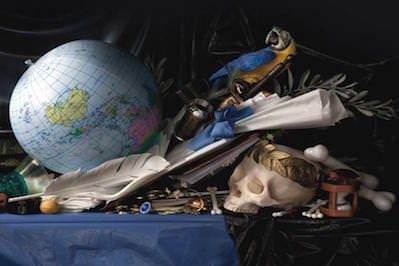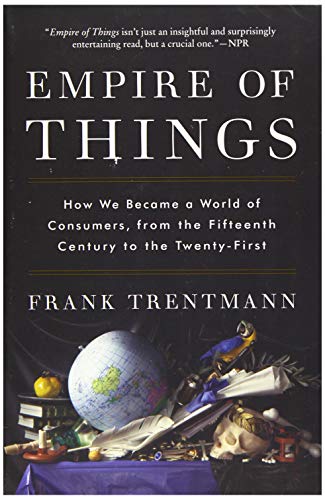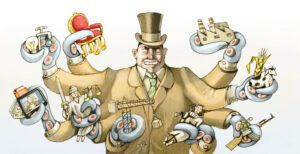Empire of Things
"Instead of warriors or workers, we are more than ever before consumers," a new book declares. "In the rich world -- and in the developing world increasingly, too -- identities, politics, the economy and the environment are crucially shaped by what and how we consume."
“Empire of Things: How We Became a World of Consumers, From the Fifteenth Century to the Twenty-First” A book by Frank Trentmann To see long excerpts from “Empire of Things” at Google Books, click here.
There are lots of books about a single thing that supposedly changed everything. They all sound the same, with titles like “Cod: A Biography of the Fish That Changed the World” or “Tea: The Drink That Changed the World” or “The Box: How the Shipping Container Made the World Smaller and the World Economy Bigger.” They’re all true, to a point, but all exaggerated — magnifying the influence of one item or product to tell a bigger story.
Frank Trentmann, a historian at Birkbeck College, University of London, takes this model and flips it: He has written a book about everything in order to illuminate the story of individual daily life. “Empire of Things” is a massively ambitious — and just plain massive — history of what and how and why we consume, a work spanning continents, centuries, ideologies, political systems, faiths, and lots and lots of physical stuff.
Though we can be described as voters or households or taxpayers or workers or whatever label suits the political calendar, Trentmann thinks our identity as consumers trumps all others. A typical German owns some 10,000 objects, he notes, while a standard Los Angeles garage may not house a car but rather hundreds of boxes of random stuff. “Instead of warriors or workers, we are more than ever before consumers,” Trentmann writes. “In the rich world — and in the developing world increasingly, too — identities, politics, the economy and the environment are crucially shaped by what and how we consume.”
But the way we think about that consumer culture is all wrong, Trentmann argues. In particular, he contests the notions that consumerism is a U.S.-driven phenomenon; that it emerged with the post-World War II economic boom; that it flows from market forces; and that it invariably reflects a move toward secularism, superficiality and transience.
Trentmann does what historians do, finding stories of personal acquisitiveness as far back as Renaissance Italy, where households began accumulating silverware and table items as markers of “domestic sociability and politeness,” and Ming Dynasty China, where “antiquities and original pieces of art were stocks to be cherished for life.” In the Netherlands, local lotteries in the 1600s offered wine goblets and silver sword handles as minor prizes; the powerball gave you a full silver table service worth 4,000 florins.
For as long as people have yearned for more stuff, intellectuals have chastised them for that desire. Even Plato’s “Republic” followed the “decline of a virtuous, frugal city as it was corrupted by the lust for luxurious living,” Trentmann reminds readers. But his true nemesis is more recent: John Kenneth Galbraith, author of “The Affluent Society” (1958), in which the late economist argued that modern society seeks not only to fulfill our needs but also to create new ones, propelling us to live beyond our means, go into debt and thus strengthen the power of business. Though Trentmann acknowledges that the book has been enormously influential in cementing popular notions of consumerism, he dismisses it as “not a sober empirical study but a piece of advocacy to justify greater public spending.”
The irony of a statist and anti-consumerist tract is that, as Trentmann makes clear, governments have been major drivers of consumption patterns and growth throughout history. “Empire” is not just a metaphor here; imperialism and colonialism take up big chunks of the author’s attention, as they created demand for and interest in new goods, on the part of both the subjugators and the subjugated. In particular, the post-Waterloo expansion of British power liberalized world trade, unleashing the movement of more stuff. “British rule brought armies and tax collectors,” Trentmann writes, “but it also spread new norms, habits and behaviours. It changed the terms of consumption.”
Without producing mini-commodity biographies, Trentmann examines the role of cotton — “the first truly global mass consumer good,” with Indian dyed cotton reaching East Africa as early as the 11th century — and explores how tea, coffee and chocolate traversed the globe, thanks to the power of conquest or proselytism. “The first European chocoholics were Jesuits and Dominicans in the New World,” Trentmann deadpans. Legacies of empire and trade affect what people think of as local or national products, the author explains. “In Belize today, treasured local dishes have their roots in imperial trade, which prized imported fish and tinned fruit over the local catch,” he writes. “The new local is the old global.” Trentmann traces how popular concerns about products evolved from place of origin to price and now, with the fair-trade movement, to supply-chain conditions.Though it’s easy to regard growing consumption as resulting from the influence of pro-market Western democracies, Trentmann shows all manner of regimes — whether progressive New Dealers or Stalinists, Nazis or anti-colonial nationalists — embracing consumerism and product symbolism for political purposes and ideological projects. In socialist systems, for instance, consumption marks one’s place in the pecking order. “The clothes people were able to buy (or not), the price they had to pay, whether they obtained things in a state store — people’s lives as consumers were defined by their relation to the state,” Trentmann writes of the early Soviet era. And he lingers on Mohandas Gandhi, who as a young man set out for England with a white flannel suit but later embraced the dhoti (a waistcloth slightly longer than a loincloth) as a marker of Indian emancipation, both spiritual and political. Gandhi “was a sartorial fundamentalist,” Trentmann concludes.
Government spending in Western nations has also contributed enormously to consumption, especially in the second half of the 20th century, Trentmann writes, with social services in housing, education and health — as well as income supports for the poor and the elderly — helping lift marginalized groups into the consumer society. “Without the rise in social spending, the bottom would have fallen out of the boom in consumer durables.” And Trentmann loves spewing out factoids showing the ever-increasing growth in the acquisition of those durables. For instance: “In 1954, still only around 7-8 percent of [French] households had a fridge or washing machine, 1 percent a TV. … By 1975, it was 91 percent, 72 percent and 86 percent, respectively.”
Trentmann attempts to remain dispassionate, avoiding the good-vs.-evil judgments of modern consumerism and simply interpreting major historical events through his laser focus on the consumer. (Even the Cold War was mainly about “whether America or the Soviet Union offered a superior material civilization,” he writes.) But it’s hard to remain the pure historian; overall, Trentmann seems favorably inclined toward our acquisition of ever more goods, seeing it less as a sign of “conspicuous consumption” (yes, Thorstein Veblen’s “Theory of the Leisure Class” is another frequent target) and more a reflection of individual memory and emotion, or part of the creation of group or personal identities. For instance, greater levels of consumer spending by the young have created a “cult of the teenager,” he writes, while, “with the exception of Viagra and stairlift, older consumers continue to be largely invisible.”
He does worry about the physical effects of consumerism on the planet, even if he is skeptical of the long-term impact of consumer-based efforts to redress it, such as fair trade or recycling; he regards the latter as “the ally of high-octane consumption, a kind of ersatz sacrament that cleanses us of our stuff.”
One thing that might have helped mitigate our environmental wreckage: a shorter book. Though Trentmann displays astonishing erudition across multiple disciplines and a voracious appetite for arcane, revelatory details and statistics, I’m not convinced that he needed 800-plus pages of text, notes, charts and images — especially for an author skilled at boiling down complicated ideas into pithy, memorable sentences. “Looking back at the twentieth century,” Trentmann writes of the rise of consumers in Asian countries, “learning to save was probably as important for the global rise in consumption as learning to want more.” Of government spending on culture and arts in Western Europe: “Those who like to listen to Shakespeare or Verdi have their own welfare state.” And of the proliferation of gadgets and domestic appliances: “The home has morphed into one gigantic socket.”
Still, I understand Trentmann’s dilemma: When you’re writing the definitive book about everything, you really don’t want to leave anything out.
Carlos Lozada is the nonfiction book critic of The Washington Post.
©2016, Washington Post Book World Service/Washington Post Writers Group
Your support matters…Independent journalism is under threat and overshadowed by heavily funded mainstream media.
You can help level the playing field. Become a member.
Your tax-deductible contribution keeps us digging beneath the headlines to give you thought-provoking, investigative reporting and analysis that unearths what's really happening- without compromise.
Give today to support our courageous, independent journalists.










You need to be a supporter to comment.
There are currently no responses to this article.
Be the first to respond.